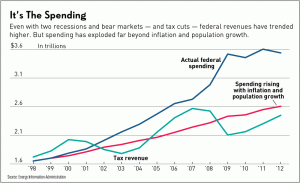Federal government revenue rose from $1.7 trillion to $2.4 trillion from fiscal 1998 to 2012, slightly exceeding inflation. Revenue growth averaged 2.9% annually, despite two recessions, bear markets — and tax cuts.
But federal spending rose nearly twice as fast — 5.7% per year — surging from $1.6 trillion to $3.5 trillion over that same span.
The spending spike also exceeds growth in the population.
Some of the spending surge came during the Bush administration — the wars in Afghanistan and Iraq, increases in non-defense discretionary spending and the creation of the Medicare prescription drug entitlement.
But spending accelerated under Obama. While he inherited a budget increase from Bush in fiscal 2009, an omnibus bill he signed plus his stimulus package helped boost spending $535 billion in his first year, hiking total spending from $2.9 trillion in 2008 to $3.5 trillion in 2009. Spending has never returned to the already-high 2008 level even after controlling for inflation.
Wear A Cap
Dan Mitchell, senior fellow at the libertarian Cato Institute, says the U.S. government needs a spending cap.
“It’s an issue of trendlines and that’s everything in fiscal policy,” Mitchell said. “If you are on a path where government spending grows faster than the private sector of the economy, which is your tax base, then in theory there is no level of taxation that will be enough to stabilize the system. … If we had kept government spending down to just increases for inflation and population growth, we wouldn’t be in the trouble we’re in now.”
Limiting spending to increases in inflation and population growth over 1998-2012 (an annual average of about 3.3%) would have given dramatically different results. The U.S. would have spent $2.6 trillion in FY 12, about $900 billion less than what it actually did. The latest deficit would be $157 billion, a fraction of the actual $1.089 trillion.
The government ran up $6.7 trillion in national debt from FY 1998-’12. Yet if spending had just risen with inflation and population, the U.S. would have reduced the debt by $177 billion.
While a spending cap would help, some analysts contend that it would need to be coupled with entitlement reform.
“If you don’t reform Social Security, Medicare and Medicaid, you’ll have a hard time staying within the cap,” said Veronique de Rugy, senior research fellow at the libertarian Mercatus Center.
Those three programs will account for about 50% of the budget by 2020, so changing them so they cost less would be crucial to the success of any spending cap.
“If you cap spending, and Congress can’t get around (it), then the rest of the budget will have to go,” said de Rugy. “The more realistic option is that Congress finds ways … around the caps.”
Raising the political bar even higher, an effective spending cap likely would require amending the Constitution.
“To make it feasible and enforceable you’d have to do a constitutional amendment,” said Mitchell. “But even short of that, at least if you start talking about it and set it as your goal it would get people focusing on the real problem … which is government spending growing faster than the private sector.”
~
Originally posted December 19, 2012 at Investor’s Business Daily.
 President Obama says he wants a “balanced” approach to the fiscal cliff. But critics argue the real problem is spending, which has far outstripped rising tax revenue as well as economic growth.
President Obama says he wants a “balanced” approach to the fiscal cliff. But critics argue the real problem is spending, which has far outstripped rising tax revenue as well as economic growth.